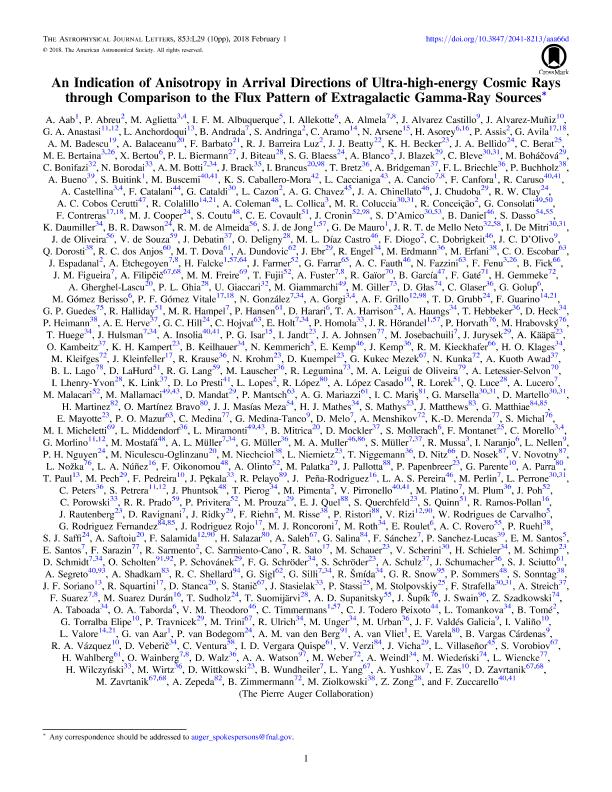Artículo
An Indication of Anisotropy in Arrival Directions of Ultra-high-energy Cosmic Rays through Comparison to the Flux Pattern of Extragalactic Gamma-Ray Sources
Aab, A.; Allekotte, Ingomar; Almela, Daniel Alejandro ; Andrada, B.; Bertou, Xavier Pierre Louis
; Andrada, B.; Bertou, Xavier Pierre Louis ; Botti, Ana Martina
; Botti, Ana Martina ; Cancio, A.; Contreras, F.; Etchegoyen, Alberto
; Cancio, A.; Contreras, F.; Etchegoyen, Alberto ; Figueira, Juan Manuel
; Figueira, Juan Manuel ; Fuster, Alan Ezequiel
; Fuster, Alan Ezequiel ; Golup, Geraldina Tamara
; Golup, Geraldina Tamara ; Gómez Berisso, M.; Gómez Vitale, P. F.; González, N.; Hampel, Matias Rolf
; Gómez Berisso, M.; Gómez Vitale, P. F.; González, N.; Hampel, Matias Rolf ; Hansen, Patricia Maria
; Hansen, Patricia Maria ; Harari, Diego Dario
; Harari, Diego Dario ; Holt, E.; Hulsman, Johannes
; Holt, E.; Hulsman, Johannes ; Josebachuili Ogando, Mariela Gisele
; Josebachuili Ogando, Mariela Gisele ; Kleinfeller, J.; Lucero, A.; Mollerach, Maria Silvia
; Kleinfeller, J.; Lucero, A.; Mollerach, Maria Silvia ; Melo, Diego Gabriel
; Melo, Diego Gabriel ; Müller, Ana Laura
; Müller, Ana Laura ; Naranjo, I.; Roulet, Esteban
; Naranjo, I.; Roulet, Esteban ; Rodriguez Rojo, J.; Sánchez, F.; Santos, E.; Sarmiento Cano, Christian Andres
; Rodriguez Rojo, J.; Sánchez, F.; Santos, E.; Sarmiento Cano, Christian Andres ; Schmidt, D.; Sciutto, Sergio Juan
; Schmidt, D.; Sciutto, Sergio Juan ; Silli, Gaia
; Silli, Gaia ; Suarez, F.; Taborda Pulgarin, Oscar Alejandro
; Suarez, F.; Taborda Pulgarin, Oscar Alejandro ; Wainberg, Oscar Isaac; Wundheiler, Brian
; Wainberg, Oscar Isaac; Wundheiler, Brian ; Yushkov, Alexey; The Pierre Auger Collaboration
; Yushkov, Alexey; The Pierre Auger Collaboration
 ; Andrada, B.; Bertou, Xavier Pierre Louis
; Andrada, B.; Bertou, Xavier Pierre Louis ; Botti, Ana Martina
; Botti, Ana Martina ; Cancio, A.; Contreras, F.; Etchegoyen, Alberto
; Cancio, A.; Contreras, F.; Etchegoyen, Alberto ; Figueira, Juan Manuel
; Figueira, Juan Manuel ; Fuster, Alan Ezequiel
; Fuster, Alan Ezequiel ; Golup, Geraldina Tamara
; Golup, Geraldina Tamara ; Gómez Berisso, M.; Gómez Vitale, P. F.; González, N.; Hampel, Matias Rolf
; Gómez Berisso, M.; Gómez Vitale, P. F.; González, N.; Hampel, Matias Rolf ; Hansen, Patricia Maria
; Hansen, Patricia Maria ; Harari, Diego Dario
; Harari, Diego Dario ; Holt, E.; Hulsman, Johannes
; Holt, E.; Hulsman, Johannes ; Josebachuili Ogando, Mariela Gisele
; Josebachuili Ogando, Mariela Gisele ; Kleinfeller, J.; Lucero, A.; Mollerach, Maria Silvia
; Kleinfeller, J.; Lucero, A.; Mollerach, Maria Silvia ; Melo, Diego Gabriel
; Melo, Diego Gabriel ; Müller, Ana Laura
; Müller, Ana Laura ; Naranjo, I.; Roulet, Esteban
; Naranjo, I.; Roulet, Esteban ; Rodriguez Rojo, J.; Sánchez, F.; Santos, E.; Sarmiento Cano, Christian Andres
; Rodriguez Rojo, J.; Sánchez, F.; Santos, E.; Sarmiento Cano, Christian Andres ; Schmidt, D.; Sciutto, Sergio Juan
; Schmidt, D.; Sciutto, Sergio Juan ; Silli, Gaia
; Silli, Gaia ; Suarez, F.; Taborda Pulgarin, Oscar Alejandro
; Suarez, F.; Taborda Pulgarin, Oscar Alejandro ; Wainberg, Oscar Isaac; Wundheiler, Brian
; Wainberg, Oscar Isaac; Wundheiler, Brian ; Yushkov, Alexey; The Pierre Auger Collaboration
; Yushkov, Alexey; The Pierre Auger Collaboration
Fecha de publicación:
02/2018
Editorial:
IOP Publishing
Revista:
Astrophysical Journal
ISSN:
2041-8213
Idioma:
Inglés
Tipo de recurso:
Artículo publicado
Clasificación temática:
Resumen
A new analysis of the data set from the Pierre Auger Observatory provides evidence for anisotropy in the arrivaldirections of ultra-high-energy cosmic rays on an intermediate angular scale, which is indicative of excess arrivalsfrom strong, nearby sources. The data consist of 5514 events above 20 EeV with zenith angles up to 80°recordedbefore 2017 April 30. Sky models have been created for two distinct populations of extragalactic gamma-rayemitters: active galactic nuclei from the second catalog of hard Fermi-LAT sources (2FHL) and starburst galaxiesfrom a sample that was examined with Fermi-LAT. Flux-limited samples, which include all types of galaxies fromthe Swift-BAT and 2MASS surveys, have been investigated for comparison. The sky model of cosmic-ray densityconstructed using each catalog has two free parameters, the fraction of events correlating with astrophysicalobjects, and an angular scale characterizing the clustering of cosmic rays around extragalactic sources. Amaximum-likelihood ratio test is used to evaluate the best values of these parameters and to quantify the strength ofeach model by contrast with isotropy. It is found that the starburst model fits the data better than the hypothesis ofisotropy with a statistical significance of 4.0σ, the highest value of the test statistic being for energies above39 EeV. The three alternative models are favored against isotropy with 2.7σ?3.2σ significance. The origin of theindicated deviation from isotropy is examined and prospects for more sensitive future studies are discussed.
Palabras clave:
Astroparticle physics
,
Cosmic rays
,
Active galaxies
,
Starburst
,
Data analysis
Archivos asociados
Licencia
Identificadores
Colecciones
Articulos(IFLP)
Articulos de INST.DE FISICA LA PLATA
Articulos de INST.DE FISICA LA PLATA
Articulos(ITEDA)
Articulos de INSTITUTO DE TEC. EN DETECCION Y ASTROPARTICULAS
Articulos de INSTITUTO DE TEC. EN DETECCION Y ASTROPARTICULAS
Citación
Aab, A.; Allekotte, Ingomar; Almela, Daniel Alejandro; Andrada, B.; Bertou, Xavier Pierre Louis; et al.; An Indication of Anisotropy in Arrival Directions of Ultra-high-energy Cosmic Rays through Comparison to the Flux Pattern of Extragalactic Gamma-Ray Sources; IOP Publishing; Astrophysical Journal; 853; L29; 2-2018; 29-38
Compartir
Altmétricas



